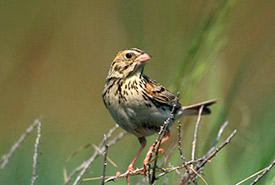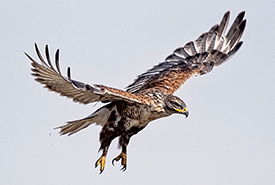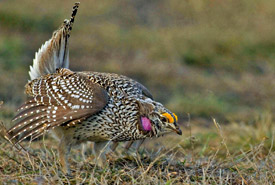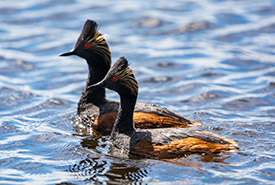Surveying birds at McIntyre Ranch

Baird's sparrow (Photo by Alan MacKeigan)
The successful campaign to conserve McIntyre Ranch is a historic milestone in the Nature Conservancy of Canada’s (NCC’s) efforts to conserve Canada’s Prairie grasslands. However, the work to care for this remarkable landscape is far from over.
One of the next steps for stewarding McIntyre Ranch is to catalogue the incredible species that live here. To achieve this, NCC conservation staff and contractors are conducting a series of biological surveys targeting a range of species and habitats across the ranch.
As an Important Bird and Biodiversity Area featuring a mixture of habitats, McIntyre Ranch contains an incredible diversity of bird life — from grassland songbirds and raptors in its uplands, to shorebirds and waterfowl in its wetlands.
And so, surveying McIntyre’s birds is a key step in informing its future management and providing crucial insights into the status of its grassland birds, whose numbers are among the fastest declining in Canada.
Eyes (and ears) on the prize
NCC staff conducted breeding bird surveys in the spring and early summer of 2023. These surveys involve “point counts,” a standardized approach in which a biologist watches and listens for birds within a fixed radius around them for five minutes.
Focused on the ranch’s grasslands, these surveys uncovered a diversity of grassland songbirds, including at-risk species such as chestnut-collared longspur and Baird’s sparrow. The presence of these diverse species and their varying habitat requirements suggests that the ranch is grazed in a way that creates areas with different vegetation lengths, an important outcome in grassland management.
Rife with raptors
McIntyre Ranch is a hot spot for raptors, with populations of species such as bald and golden eagle, ferruginous hawk and prairie falcon.

Ferruginous hawk (Photo by Leta Pezderic / NCC Staff)
Last field season, biologists surveyed potential nesting habitats on the ranch, such as trees, cliffs and human-built structures, for signs of raptor nesting activity and found many nests occupied by several different species!
Documenting sensitive nest sites is crucial for both conservation efforts and understanding the breeding status of species within the province. Identifying these sites helps them be avoided, minimizing any disturbance, and also provides valuable data on the reproductive success of each species.
Shaking their tail feathers
Starting this spring, biologists will be searching the ranch for sharp-tailed grouse, which congregate at sites known as leks to breed. Here, males perform elaborate courtship dances while females observe the show with a watchful eye to decide who to mate with.
Male sharp-tailed grouse exhibit a distinct social hierarchy. Dominant males usually claim central positions within the lek, so they are more visible to females, and, as a result, have a higher chance of mating with females.

Male sharp-tailed grouse (Photo by Rick Howie)
During lekking, sharp-tailed grouse are sensitive to disturbance. Identifying and mapping these spots can help minimize human impacts around them, which helps protect these important places that are often occupied by grouse year after year.
Floating nests
McIntyre Ranch contains several large lakes, including Ross and Reed lakes. This summer, these large waterbodies within the ranch will be surveyed for waterbirds, such as western and eared grebes, waterfowl and shorebirds. These surveys will help identify important nesting habitats and inform recommendations on how to protect and enhance these habitats.
Grebes are fascinating species that build floating nests using aquatic vegetation, typically in colonies.

Eared grebe (Photo by Leta Pezderic)
The size of the breeding colony varies depending on factors such as habitat availability and food abundance, and range from a few pairs to several hundred pairs in each waterbody
Painting a picture of prairie wildlife
By conducting these comprehensive wildlife surveys, NCC aims to gather crucial data on the incredible bird biodiversity of McIntyre Ranch. This information will not only guide future conservation efforts but also provide a baseline for monitoring ecosystem health and assessing the effectiveness of stewardship activities there over time. Through ongoing research and stewardship, McIntyre Ranch will continue to thrive as vital habitat for birds, contributing to the conservation goals of NCC’s Prairie Grasslands Action Plan.




